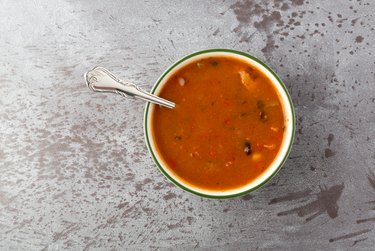
As the saying goes, if it sounds too good to be true, it probably is — and the Progresso soup diet is no exception. Like other soup diets, the Progresso diet plan requires you to replace two meals with Progresso soups to help you lose weight.
The Academy of Nutrition and Dietetics warns against this kind of fad diet, however. Any diet plan that promises rapid weight loss or limits you only to specific foods is not likely to be sustainable in the long run.
Video of the Day
Video of the Day
Weigh the pros and cons and talk with your doctor before starting a Progresso soup diet or any other diet that restricts you only to certain foods. While a canned soup diet may result in weight loss initially, it might not help you keep it off in the long term. It also might not provide you with optimal nutrition for your needs.
Progresso Soup Diet Considerations
Eating the same thing over and over can get boring, making it more difficult to stick to the Progresso Soup Diet. The Academy of Nutrition and Dietetics explains that you also might miss out on key nutrients if you eliminate entire food groups.
The Progresso diet plan doesn't specify which types of soups to eat. Theoretically, then, if you only eat Progresso New England Clam Chowder, you'll be eating minimal nutrients. Each serving size contains 0 percent of the recommended daily intake for many vitamins and minerals, such as calcium, magnesium and vitamins A, D, B and C.
In addition, although there are some healthier options for canned soups, many of them contain a high amount of sodium. The 2015-2020 Dietary Guidelines for Americans advise consuming no more than 2,300 milligrams of sodium daily — a number you may exceed if you're eating canned soup for two meals a day.
For example, the New England Clam Chowder mentioned above has 760 milligrams of sodium per serving. That's 1,520 milligrams if you eat two servings a day, and that's assuming you don't eat more than the recommended serving size of 1 cup, which is just 170 calories. It also assumes your other meals and snacks won't push you over 2,300 milligrams of sodium.
Read more: How Much Weight Can You Gain From Sodium?
Focus on the Long Term
Additionally, severely restricting calorie intake may work against your weight-loss goals over time. Research published in Perspectives on Psychological Science in September 2017 notes that severely cutting caloric intake may not help you lose weight in the long term, despite any initial weight loss.
Evidently, diet-induced weight loss results in changes to appetite gut hormones, which then contributes to an increase in appetite and weight regain. According to the research, any short-term reduction in energy intake may be counteracted by a reduction in metabolic rate and an increase in calorie intake. This means your body may end up burning fewer calories — and you end up eating more and regaining any lost weight (and then some, in some cases).
This doesn't necessarily mean a canned soup diet results in weight gain, and you may be able to achieve sustainable results — but the type of soup matters. Focus on eating nutrient-dense soups that fill you up but also keep you within the right calorie range for weight loss — a number you can calculate online via the American Council on Exercise (ACE) using your age, sex, weight, height and activity level.
Get Your Macronutrients Right
You'll also need a proper balance of micronutrients, as in carbohydrates, fats and proteins. The standard ratio is 45 to 65 percent carbohydrates, 20 to 35 percent fats and 10 to 35 percent proteins. However, ACE recommends customizing your macronutrient profile based on your goals. For example, for weight loss, you may wish to eat about half your calories in carbohydrates, 20 to 25 percent in fats and 25 to 30 percent in proteins.
The quality of those macronutrients matters, too. The Dietary Guidelines for Americans advises filling your diet with a variety of colorful vegetables and fruits, lean proteins, fat-free or low-fat dairy, whole grains and healthy fats like avocado. In addition to limiting sodium intake, avoid added sugars — and if you drink alcohol, do so in moderation: up to one drink per day for women and two drinks for men.
Keep in mind, you can always add vegetables to canned soup to increase your nutrient intake and feel more full after meals. For even greater results from your Progresso diet plan or any diet, add physical activity and strength training to your routine.
- Academy of Nutrition and Dietetics: "Staying Away from Fad Diets"
- Progresso: "New England Clam Chowder"
- Office of Disease Prevention and Health Promotion: Dietary Guidelines 2015-2020: "Key Elements of Healthy Eating Patterns"
- National Center for Biotechnology Information, U.S. National Library of Medicine: Perspectives on Psychological Science: "Reducing Calorie Intake May Not Help You Lose Body Weight"
- American Council on Exercise: "How to Determine the Best Macronutrient Ratio for Your Goals"
- American Council on Exercise: "Tools & Calculators"